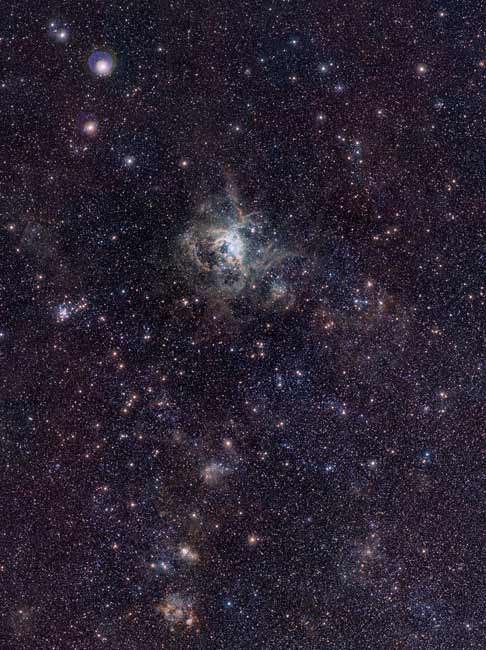Baby Stars Sparkle in New Photo of Tarantula Nebula

Violetsparkles of baby stars lighten the dark field of the Tarantula Nebula,ayellow-tinged cloud of gas in a nearby galaxy, in a new photo releasedthisweek.
Captured bythe European Southern Observatory (ESO)'s VISTA telescope at theParanalObservatory in Chile, this image is one of the first taken in anambitious surveyof our neighboring galaxy, the Large Magellanic Cloud. [Seethe new photo]
"Thisview is of oneof the most important regions of star formation in the local universe ?thespectacular 30 Doradus star-forming region, also called the TarantulaNebula," said lead researcher Maria-Rosa Cioni of theUniversity ofHertfordshire in the U.K. "At its core is a large cluster of starscalledRMC 136, in which some of the most massive stars known are located."
Most of theyoung stars in this region are cloaked by gas and dust wherethey were formed.But the near-infrared wavelengths that the VISTA telescope observes inarelonger than visible light, making them able to pierce theseobstructions andilluminate the fine details of nebula.
By the endof the VISTA MagellanicCloud Survey, the telescope will have imaged 184 squaredegrees of the sky? equivalent to 1,000 times the area of the full moon as seen fromEarth.
"TheVISTA images will allow us to extend our studies beyondthe inner regions of the Tarantula into the multitude of smallerstellarnurseries nearby, which also harbor a rich population of young andmassivestars," said researcher Chris Evans from the VISTA survey team. "Armedwith the new, exquisite infrared images, we will be able to probe thecocoonsin which massive stars are still forming today, while also looking attheirinteraction with older stars in the wider region."
The newimage already shows a variety of star systems: Outside the TarantulaNebula inthe center, the NGC 2100 starcluster flanks it to the left while a remnant of supernovaSN1987A (eso1032)glows to the right. Star-formingregions below comprise NGC 2080 (known as the "Ghost Head Nebula"),and the NGC 2083 star cluster.
Breaking space news, the latest updates on rocket launches, skywatching events and more!
Over thenext five years, VISTA will be used for five more near-infrared surveysof thesouthern sky, ESO officials said in a statement.
- Images:Spectacular Nebulas
- Top10 Strangest Things in Space
- Images? Fantastic Views of Alien Galaxies
Zoe Macintosh is a science writer who covered human spaceflight, astronomy and science for Space.com in 2010. She also covered general science for Space.com's sister site Live Science. Zoe studied English literature and physics at Smith College, where she also wrote for the Smith Sophian. Her work has also appeared in the National Association of Science Writers website.
